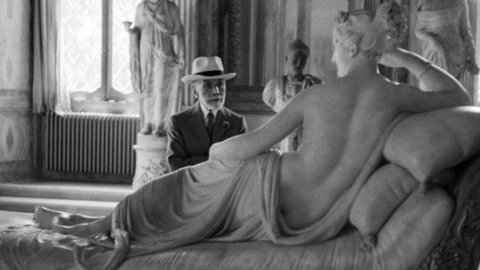The first was Henri Cartier-Bresson. He, the undisputed master, and his work on Italy, is entrusted with the heart of the exhibition and with the task of introducing the first photographic itinerary through 20 photographs from the 30s onwards which, together with those of 35 other authors present, will contribute to give us back the "image" of our country seen with the lens of the greatest international photographers.
To tell how the great international photographers have seen Italy over a period of almost eighty years, the exhibition is divided into seven large thematic areas, within which an indirect history of photography and the evolution of its languages.
Promoted and produced by Municipality of Milan Culture, Palazzo della Ragione, with Civita, Contrasto and GAmm Giunti and curated by Giovanna Calvenzi, the review closes the path dedicated to Italy wanted in the year of Expo 2015 and which began last March, with the exhibition dedicated to Italian photographers. The exhibition space of the Palazzo della Ragione, entirely dedicated to photography, inaugurated in June 2014 in the heart of Milan, enriches its schedule with a selection of unmissable images.
“After Italia Inside Out, the exhibition that last spring gave the public images taken by great Italian photographers, we are now opening, again at Palazzo della Ragione, the second part of this project which reproduces the gaze, both enchanted and attentive , of the great international photographers on our country. Fascinated by its landscape, its people, its history, the artists on display reveal to us who inhabit it the amazement that our country arouses abroad, in cultures and sensitivities different from ours, forcing us to reflect on the value of our natural, artistic, historical and social heritage. – declared the Councilor for Culture Filippo Del Corno – A perfect project for ExpoinCittà, which has been able to offer the Milanese and visitors, in these six months, the best of Italian and international creative talent”.
The long trip to Italy begins with a self-portrait by Henri Cartier-Bresson of 1933: his humanist dream of stopping time, of seizing the decisive moment in the flux of reality will influence photography around the world for a long time and will be adopted by generations of photographers.
After Cartier-Bresson, and his journey which lasted about thirty years, the reportage by Robert Capa following the American troops during the Italian Campaign of 1943, follows the elegant reinterpretation of the world of faith faced by David Seymour and the fascination that a minor Italy exerts on Cuchi Whitestill a photography student. Then the humanist vision dissolves in the classic lights of the story of Herbert List or in the destabilization of the vision of William klein who enters the provocative story of Rome in 1956 as a protagonist. Finally Sebastião Salgado who, with his usual masterful ability to re-read the reality of men, tells the story of the last tuna fishermen in Sicily.
We then move on to the fascination for black and white photography in which the narrative distances itself from reportage but preserves the poetry of the classic vision intact: it is the journey of Claude nori which retraces the streets of memories on the Adriatic coast in search of family roots but is also the unprecedented vision of the capital of Helmut Newton who in "72 hours in Rome" recreates a night walk in the monumental center of the city
Our cities of art and culture then become grounds for interpretation and experimentation with the many languages that contemporary technology offers photography today. Abelard Morell, for example, using pinhole techniques, he creates visions in which interiors and exteriors add up, Gregory Crewdson rediscovers black and white photography to interpret Cinecittà, Irene Kung instead it recreates a dreamlike atmosphere to portray the monuments of Milan's past and present.
To introduce the fourth itinerary, entrusted to authors who use what is usually called "documentary language", is found Paul Strand, which with Cesare Zavattini created one of the most extraordinary works dedicated to rural life: A Country from 1953. Through portraits, still lifes and landscapes, Strand preserves the history of a small town in Emilia, Luzzara.
Fifty years later but with the same intention Thomas Struth portrays the historic center of Milan e Joan Fontcuberta he dedicated himself to the cabinets of curiosities of the scientific museums of Bologna and Reggio Emilia.
The Grand Tour continues touching even a more disturbing photograph, that of the existential unease and architectural havoc of Art kane, which designs sandwich-images dedicated to the salvation of Venice and of Michael ackerman which instead recounts a painful Neapolitan encounter in a long sequence.
These images are counterbalanced by numerous authors who re-read our country with a positive outlook: Joel meyerowitz tells the magical lights of Tuscany and enriches its images with the poetic contribution of Maggie Barrett, Steve McCurry, in Venice, is fascinated by the aesthetic alchemy that is created between people and the environment and Martin Parr instead, on the Amalfi coast, he plays with the image of tourists who dedicate themselves to portraying themselves against the background of extraordinary landscapes.
The autobiographical narration ideally closes the exhibition itinerary: Araki Nobuyoshi, who was also fascinated by the city of Venice, photographed himself with carnival masks and recounted his encounters in a subjective key. Sophie Zenon retraces the history of her family, forced to emigrate, juxtaposing the portraits of her grandparents with their places of origin and finally Elina brotherus and his self-portraits in the landscape which are connected at the beginning of our itinerary to the astonishing and very modern self-portrait of Henri Cartier-Bresson which started this long journey.
From 11 November to 7 February 2016, in Milan, Palazzo della Ragione Photography hosts "Henri Cartier-Bresson and the others - Great photographers and Italy".





